Art and Creative Thinking in ELT
Chrysa Papalazarou has been teaching English in different Greek state schools for over twenty years. She is currently working in a state primary school. She is interested into how the interweaving of the aesthetic and social awareness component of artworks can introduce values and wider world issues to students, and promote a more thoughtful and creative flow in English language teaching and learning. She posts her articles on the Art Least blog. Chrysa is a member of the C Group and the Visual Arts Circle. E-mail: hryspap@yahoo.gr
Introduction
This article is a description and reflection on a workshop I gave during the Tesol Greece annual convention in March called Be creative and Inspire. The workshop was on art and creative thinking in ELT. We explored how the integrated use of artful stimuli and thinking routines woven around social topics can foster the development not only of students’ language skills, but also help them develop their creative thinking. The workshop had three parts.
Part I - Looking 10x2
In the first part we worked together on the Looking 10x2 routine with The Wrested Heart, an intriguing piece of artwork by Peggy Lipschutz, an American artist and activist.
The Wrested Heart by Peggy Lipschutz
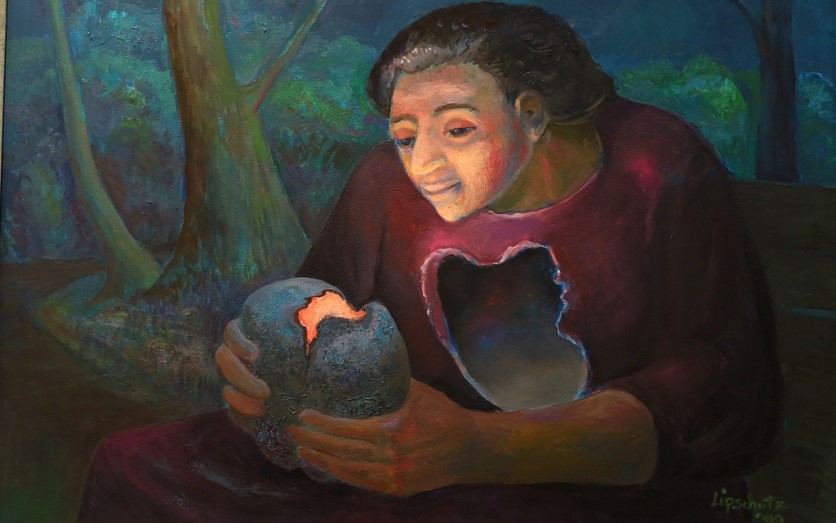
Looking 10x2 is a routine that helps learners slow down, concentrate, observe carefully and describe. The routine stems from the Artful (Visible) Thinking programme of Harvard's Project Zero. Having a focus on understanding learning in and through the arts, Artful Thinking aims at helping students develop thinking dispositions that foster thoughtful learning. The specific routine comprises of the following steps:
- Introduce the source material. This may be any kind of image, painting or artwork, especially visual art.
- Ask students to concentrate and look at the source material for thirty seconds. If the source material is rich in details, you can extend the time to one minute.
- Ask them to take notes and make a list of up to ten words or phrases about any aspect of what they have just seen. In this stage students can work individually, in pairs or in small groups.
- Work as a whole class and share ideas. As students come up with their words and phrases, keep a visible record on the board by using a brainstorming diagram or a concept map. A circle map works well with this routine. Ask students to take notes of the ideas shared in class.
- After going through the above steps, repeat them one more time. That is, ask students to look for another thirty seconds, add more words and phrases to their list, and share them.
As this is a routine that helps students generate descriptive language, it is a useful springboard into a writing activity. After completing the routine ask them as a writing assignment to produce a short text reflecting on the activity, the classroom discussion or elaborating further on the thoughts and ideas the routine triggered.
While the workshop participants were sharing their ideas, I wrote them on a flip chart board in a circle concept map. I used a red marker for their initial words and phrases and a green one for the ones they came up with when we repeated the routine. In the centre I wrote the title of the painting and the name of the painter.
Teacher responses
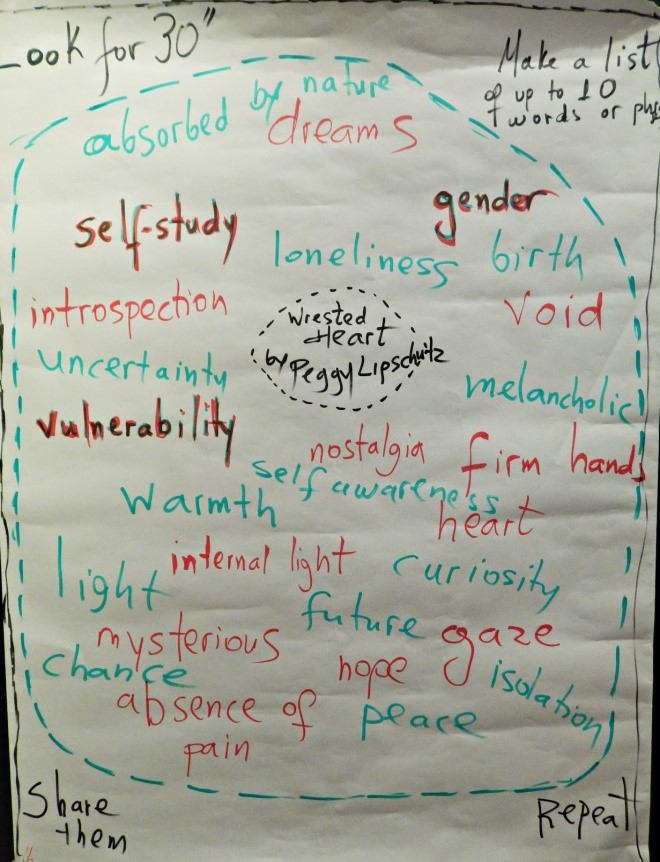
It was interesting to see the difference in the level of abstraction between the students in my classroom (age 11) on an earlier occasion, and the teachers in this workshop. This may be because young students and teachers have different approaches to perception when looking at art. Approaches sometimes referred to as either top-down in the case of adults or bottom-up in the case of children. Perception means that we hypothesize about what we see. When adults perceive and interpret art, prior knowledge and experience may influence their reactions. In the bottom-up approach which is what children do, their perception starts right at what they have in front of them. They focus on surface features of the paintings. Yet having a second look or being provided with some additional information will influence their attention towards top-down processing.
Student responses
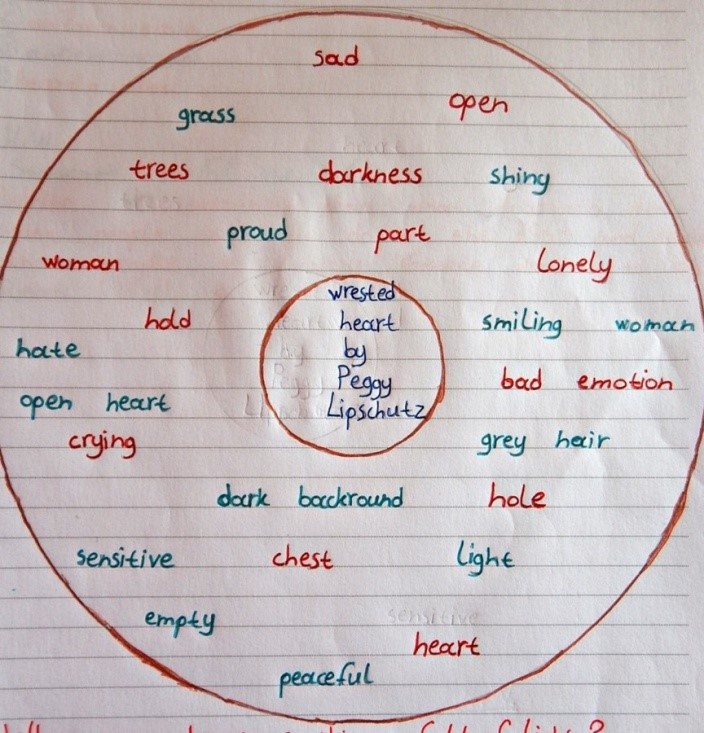
For example, when we worked on this routine in class, most of their first responses were factual (trees, woman, heart, hole, chest, hold, darkness) and at the same time their initial reactions were drawn more towards negative impressions (bad emotion, lonely, crying, sad). That looks quite natural to me since the image of a woman sitting alone in a dark forest with an empty hole in the place of her chest where her heart is supposed to be, may allude to something bleak. When we had a second look, however, their next round of words and phrases was different. The students had the chance to notice details like the glow in the woman’s face which they saw as a reflection of her shiny heart. They observed more carefully her expression which now seemed to them peaceful and they came to the conclusion that this woman may be sensitive, smiling and proud of herself.
Part II - Thinking routines in my classroom practice
The second part of the workshop was organized in two sub-parts:
First, we had a look at four more routines I have used in class. I showed how they can work with paintings, literature or poetry, and topics they can be associated with.
Routine: See, think, wonder
Visual: Guernica by Pablo Picasso
Topic: war/peace
Learning points: observation, description, triggering curiosity, wondering, asking questions
Routine questions: What do you see? What do you think about it? What does it make you wonder?
Student work
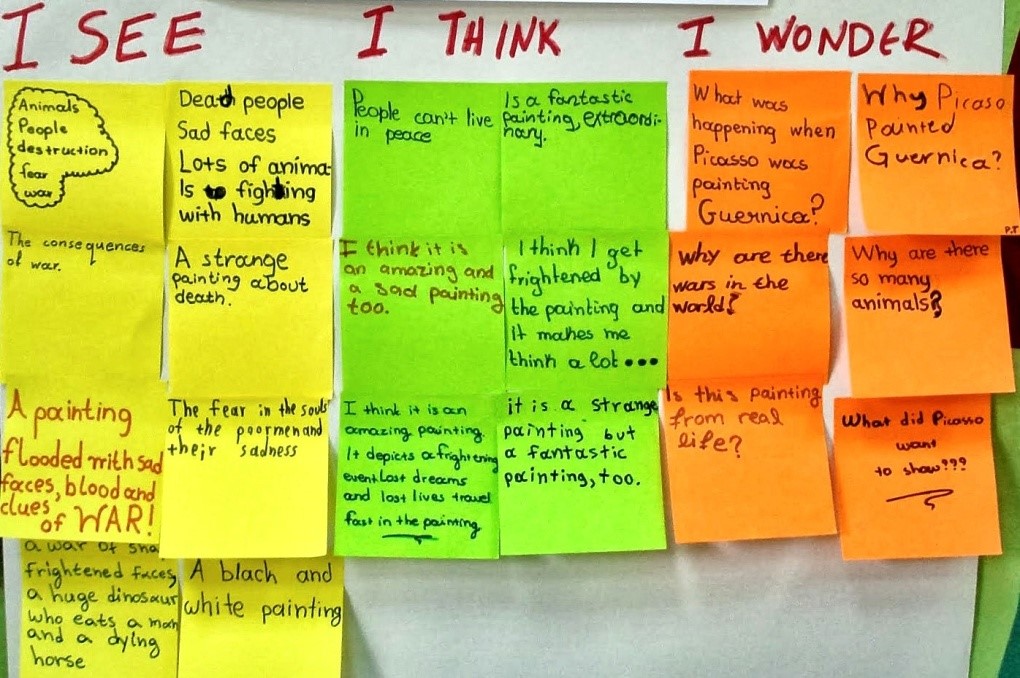
Routine: What makes you say that?
Visual: Returning from Work by L.S. Lowry
Topic: urbanization/alienation
Learning points: observation, description, reasoning with evidence from details
Routine questions: What’s going on in this painting? What do you see that makes you say that?
Student work
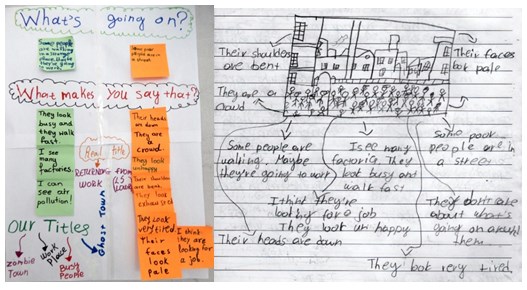
Routine: Perceive, believe, care about
Literary text: The Giving Tree by Shel Silverstein
Topic: deforestation and human greed
Learning points: building appreciation of multiple perspectives, help stimulate empathy
Routine questions: Step inside the painting/ short literary text. Imagine you are the X character. From this perspective reflect on these questions: What do you perceive? What do you believe? What do you care about?
Student work
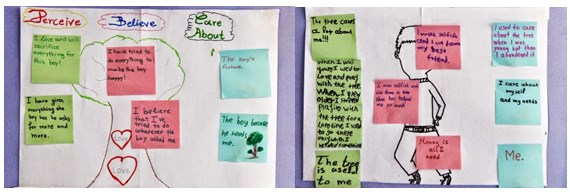
Routine: Sentence, phrase, word
Poem: Here I am by Electra Alexandropoulou
Topic: refugees
Learning points: capturing the heart with a focus on what speaks to them, building justifications
Routine questions: Choose a sentence (or line), a phrase, and word that struck you as meaningful, important or powerful. Why did you choose them?
Poem & Student work
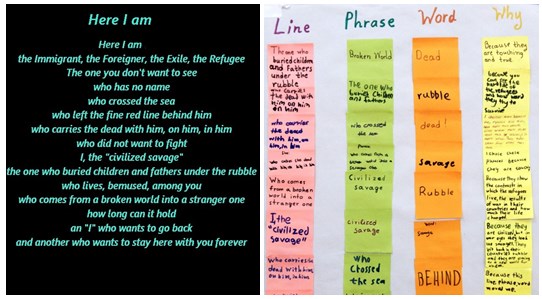
After the routines had been presented, we further considered the concept of routines as structures that facilitate working with art in the classroom, promote curiosity and discovery, observation and interpretation, making connections, and building on ideas. There was also a mention of the major projects that have been formative in the development of the visible thinking approach, namely Visual Thinking Strategies, Artful Thinking and Project Zero.
We explored the link between visible thinking and creativity. The repeated engagement of students with these routines when working with paintings, but also other artful learning stimuli, helps them activate thinking-dispositional behaviour such as curiosity, concern for truth and understanding, and helps nurture a creative mindset (Tishman & Palmer, 2007). It is a view of creativity as a process in which the core idea of “making something new”, an idea at the heart of creativity (Maley, 2015), meets the development of students’ individual and collective conceptual schemata for understanding and interpreting the world.
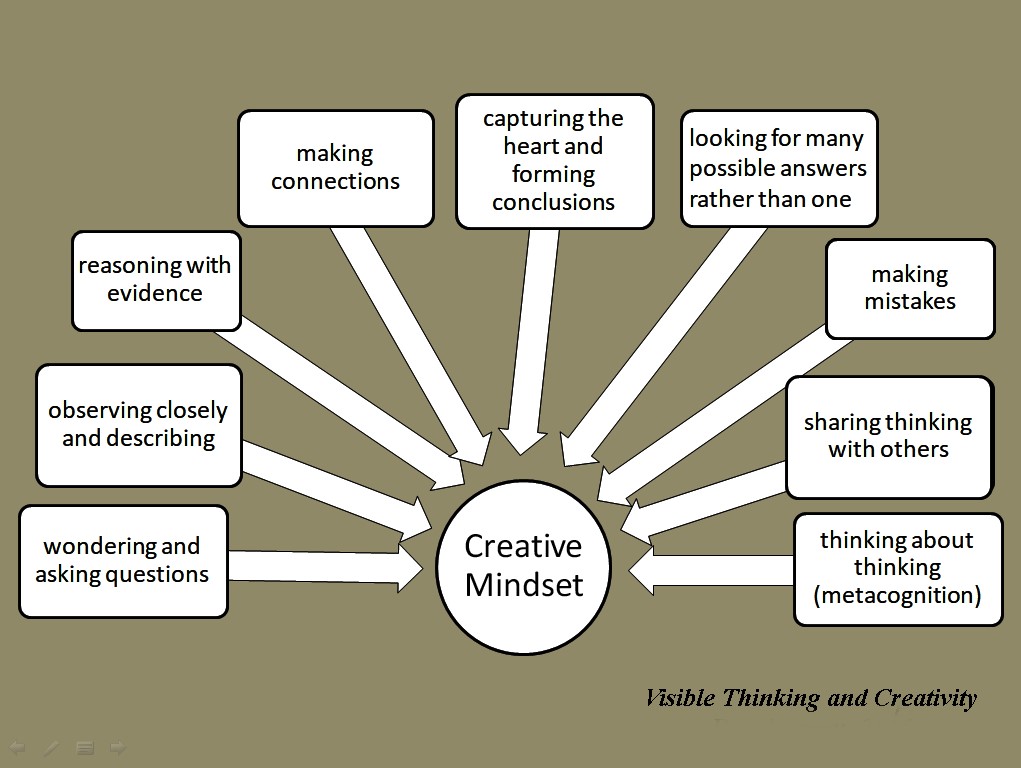
Part III - Which thinking routine or topic?
In the final third part of the workshop we looked at some artworks and engaged in a free exchange of ideas on the routine the participants would use or which topic they could associate the artwork with. From the artworks included in the workshop materials we had the time to discuss:
In the village or Picking cotton by Louay Kayyali
Then what or What after by Louay Kayyali
Killing ourselves by Santiago Pejac
Inherit the dust by Nick Brandt
The group came up with some interesting ideas. For example, when I showed them Then what or What after, a painting by Louay Kayyali, a Syrian visual artist, one of the participants offered the idea of using the ‘Sentence, phrase, word’ routine. This is a routine that is normally about reading and capturing the essence of a text. What this participant creatively did was to regard the image itself as text. Asking students to observe carefully, “read” the image and cut down their impressions and expression to a single sentence, phrase or word, calls for them to focus their attention better to those characteristics of the painting that are strikingly salient for them. The ideas are bound to be highly personalized and different for each student and will offer a diversity of meaning making. I myself tried out this participant’s idea a couple of days later with one of my classes and it also worked nicely there.
Then what or What after by Louay Kayyali
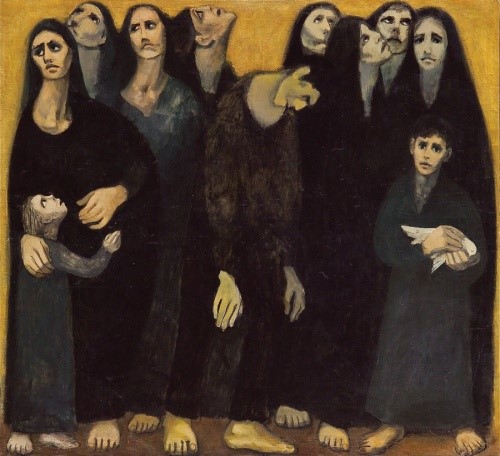
Another interesting moment was when we were looking at the street art piece Killing ourselves by a Spanish artist, Santiago Pejac. We discussed what topic they could associate it with. I had initially thought of linking it with the human factor in forest destruction, but the participants put forward a range of other interesting ideas. They suggested immigration, disconnected society, and social media alienation.
Killing ourselves by Santiago Pejac

Workshop feedback and reflection
At the end of the workshop I asked participants to reflect on the following questions of the “I used to think…now I think…” routine:
- What did you use to think about art and creative thinking in English language teaching before this workshop?
- What do you think about it now?
This is a routine that promotes reflection on how thinking and ideas might have changed as understanding of an issue develops through watching, viewing, reading, or discussing new information.
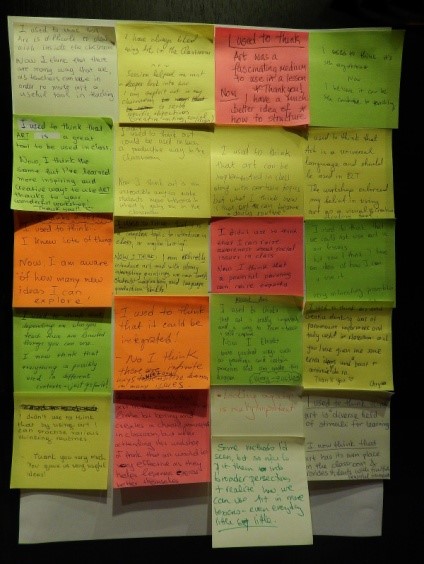
Looking at their feedback I have the firm belief that many teachers would want to use art in their classes. I think this is something that education and training courses should take into consideration. I would like to think that this workshop helped some of the participants debunk perceptions and beliefs about the use of art in the English classroom, namely that:
- art can be difficult to use in the classroom
- art is vague and abstract
- art has limited uses
- art creates a chaotic atmosphere
- art is complex or maybe boring
- art can be reserved for some special occasions at most
- art cannot be used to raise social awareness
It was gratifying to notice that quite a few of them like, believe in or already integrate art in their teaching situations. For them I am happy that the workshop provided
- a framework for a structured approach towards the use of art in ELT
- a specific link between art, social issues, and creative writing
- an inspiring and creative way to move forward
- a broader perspective
- a boost to continue using art
The workshop participants invariably stressed the importance of a structured approach towards the use of art in the English language classroom and I think that this resonates with what Alan Maley often refers to as “positive constraints” which allow creativity to flourish. The presence of a framework which also acts as a support is indeed important in language learning (Maley, 2015, 2016).
I am happy this workshop gave participants food for thought and encouraged them to explore the potential that such an approach can have in English language teaching and learning. I also feel grateful that the people who attended this workshop participated with warmth and were eager to contribute their ideas and comments. I learnt a lot from them, too.
Note. This article is an extended version of a post that first appeared in Chrysa's blog Art Least on March 10th, 2018 with the title “Art and creative thinking workshop: looking back”. The workshop materials can be accessed at this link.
References
Maley, A. 2016. Creativity - the what, the why and the how. In D. Xerri & O. Vassalo (Eds.), Creativity in the English language classroom (pp. 9-18). Malta: ELT Council. Retrieved from https://bit.ly/2I6tJW5
Maley, A. 2015. Overview: Creativity - the what, the why and the how. In A. Maley & N. Peachey (Eds.), Creativity in the English language classroom (pp. 6-13). London: British Council. Retrieved from https://bit.ly/2jjbs9Z
Papalazarou, C. (2017). Images on Canvas: art, thinking and creativity in ELT. In K. Donaghy & D. Xerri (Eds.), The Image in English Language Teaching (pp. 89-103). Malta: ELT Council. Retrieved from https://bit.ly/2w3erN9
Papalazarou, C. (2015). Making thinking visible in the English classroom:
Nurturing a creative mind-set. In A. Maley & N. Peachey (Eds.), Creativity
in the English language classroom (pp. 37-43). London: British Council.
Retrieved from https://bit.ly/2jjbs9Z
Ritchhart, R., Church, M., & Morrison, K. (2011). Making thinking visible:
How to promote engagement, understanding, and independence for all
Learners. San Francisco, CA: Jossey-Bass.
Tishman, S., & Palmer, P. (2007). Works of art are good things to think
about. Paper presented at Evaluating the Impact of Arts and Cultural
Education Conference, Paris, France. Retrieved from https://bit.ly/2reZq5S
Resources
Acknowledgements
List of artworks and artists mentioned in this article:
Wrested heart by Peggy Lipschutz
Guernica by Pablo Picasso
Returning from work by L.S. Lowry
In the village or Picking cotton by Louay Kayyali
Then what or What after by Louay Kayyali
Killing ourselves by Santiago Pejac
Inherit the dust by Nick Brandt
Here I am a poem by Electra Alexandropoulou included in the book “The Coldest Summer” (2015). I. Meitani (Ed.). Brussels-Athens: Rosa Luxemburg Stiftung. Retrieved from https://bit.ly/2I4Aurv
The Giving tree by Shel Silverstein
Please check the Creative Methodology for the Classroom course at Pilgrims website
Art and Creative Thinking in ELT
Chrysa Papalazarou, Greece